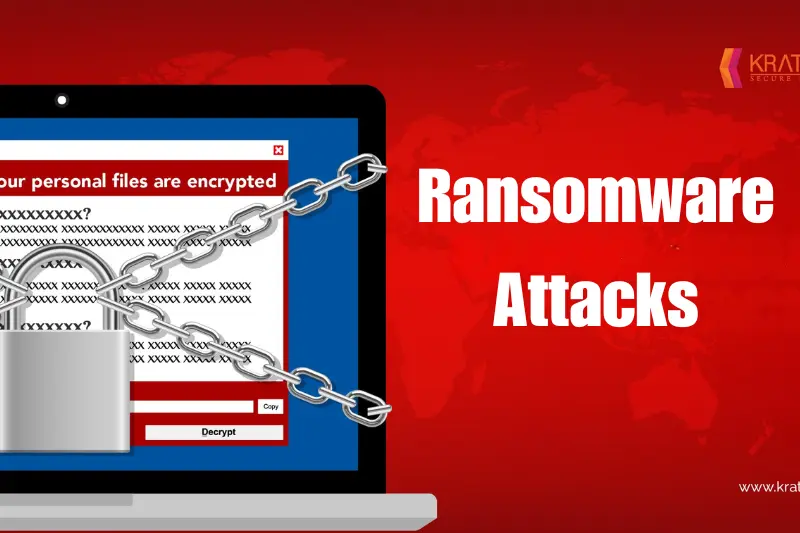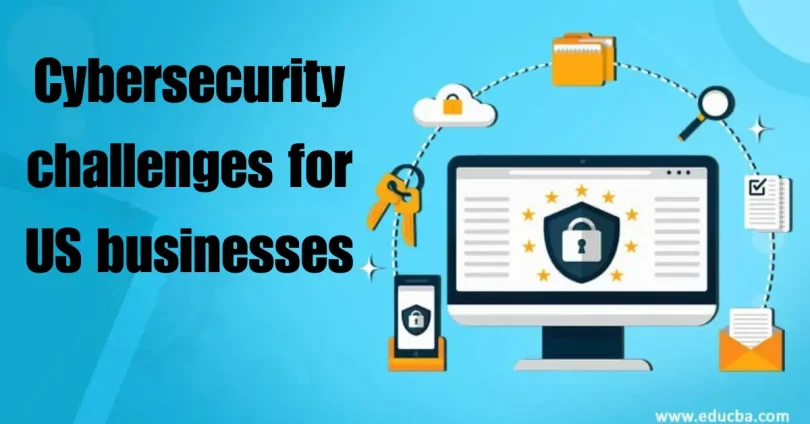In an increasingly digital world, businesses across the United States are facing significant challenges when it comes to cybersecurity. The rapid adoption of technology, along with the rise of sophisticated cyber threats, has made it more crucial than ever for organizations to protect their data and networks from malicious attacks.
This article delves deeply into the major cybersecurity challenges for US businesses, the risks these challenges present, and the strategies that organizations can employ to mitigate these risks.
1. Ransomware Attacks
 Ransomware has emerged as one of the most dangerous cybersecurity threats in recent years. In a ransomware attack, cybercriminals encrypt a company’s files and demand a ransom, typically in cryptocurrency, for the decryption key. If the ransom is not paid, the business faces prolonged downtime, loss of critical data, and potentially irreparable damage to its reputation.
Ransomware has emerged as one of the most dangerous cybersecurity threats in recent years. In a ransomware attack, cybercriminals encrypt a company’s files and demand a ransom, typically in cryptocurrency, for the decryption key. If the ransom is not paid, the business faces prolonged downtime, loss of critical data, and potentially irreparable damage to its reputation.
Ransomware attacks often target industries with valuable data, including healthcare, finance, manufacturing, and government organizations. For instance, hospitals have been frequent targets, as their data is crucial for patient care. These attacks can cripple operations and endanger lives. The high-profile attack on Colonial Pipeline in 2021 highlighted the severe impact of ransomware on the nation’s critical infrastructure, leading to fuel shortages and financial losses.
Ransomware attacks are becoming more sophisticated, with attackers leveraging advanced methods like double extortion. This technique involves not only encrypting data but also stealing it and threatening to release it unless the ransom is paid. The increase in ransomware-as-a-service platforms has also made it easier for cybercriminals to execute these attacks, even without significant technical expertise.
Mitigation Strategies:
- Regular Backups: Ensure frequent backups of critical data, stored both offline and in secure cloud environments.
- Security Software and Patching: Use robust security tools like endpoint protection, and regularly update software to fix vulnerabilities.
- Employee Training: Conduct phishing simulation exercises to train staff on identifying malicious emails and links.
- Incident Response Plans: Develop and test a comprehensive incident response plan to quickly address and contain attacks.
You may also like to read this:
Top Emerging Tech Startups In The USA To Watch In 2025
Top AI Trends In 2024: Revolutionizing Business And Tech
Top Tech Trends 2024 USA: AI, Quantum Computing, 5G & More
Top Tech Stock Market Trends In 2024: AI, Cloud & More
12 Best New Tech Gadgets 2024 You Can’t Miss
2025’s Latest Technology Updates: Breakthroughs In AI
2. Phishing and Social Engineering Attacks
Phishing remains one of the most effective tools in a cybercriminal’s arsenal, and it is a significant cybersecurity challenge for US businesses. Phishing attacks are designed to deceive individuals into revealing sensitive information, such as login credentials, credit card details, and personal data. These attacks typically come in the form of fraudulent emails, phone calls, or text messages, which appear to come from legitimate sources like banks, tech companies, or even internal organizational departments.
Phishing attacks have become more sophisticated over time. Modern phishing campaigns, also known as “spear phishing,” target specific individuals or companies, often exploiting personal information to appear more credible. Social engineering, where attackers manipulate individuals to gain access to sensitive information, frequently accompanies phishing. For example, an attacker may impersonate a trusted company executive and trick an employee into transferring funds or revealing login credentials.
As phishing and social engineering attacks grow more advanced, traditional defense mechanisms like spam filters are becoming less effective, leaving businesses vulnerable to these attacks.
Mitigation Strategies:
- Multi-factor Authentication (MFA): Require MFA for accessing critical systems to add an additional layer of protection in case of compromised credentials.
- Phishing Awareness Training: Educate employees on how to recognize phishing attempts, suspicious email attachments, and websites.
- Email Filtering and Security Software: Use advanced email filtering systems to detect and block phishing emails before they reach employees.
- Simulated Phishing Campaigns: Conduct regular simulated phishing exercises to reinforce awareness and teach employees how to respond appropriately.
3. Data Breaches and Insider Threats
Data breaches are a serious concern for US businesses, as the theft or unauthorized access to sensitive customer, employee, or business data can have devastating consequences. Cybercriminals often exploit vulnerabilities in an organization’s infrastructure or third-party vendor systems to gain unauthorized access. Once they infiltrate a system, they may steal or compromise valuable data such as financial information, intellectual property, and personal identifiers.
In addition to external threats, insider threats pose significant risks. Employees, contractors, or business partners with access to sensitive data may either intentionally or unintentionally expose it. Insiders may sell proprietary information, leak trade secrets, or mishandle data, which can lead to significant reputational damage and legal consequences.
The growing regulatory environment around data privacy also means that businesses must be extra vigilant in protecting customer data. Regulations like the General Data Protection Regulation (GDPR) and the California Consumer Privacy Act (CCPA) impose heavy penalties on organizations that fail to protect personal data.
Mitigation Strategies:
- Data Encryption: Encrypt sensitive data both in transit and at rest to ensure that even if data is intercepted, it remains unreadable.
- Strict Access Controls: Implement role-based access controls (RBAC) and the principle of least privilege, ensuring that employees only have access to the data necessary for their roles.
- Behavioral Analytics: Use advanced behavioral analytics tools to detect unusual activity that may indicate a potential insider threat or data breach.
- Security Awareness and Monitoring: Continuously monitor employee access and usage patterns, and enforce security best practices.
4. Supply Chain Attacks
 Supply chain attacks are increasingly being recognized as one of the most dangerous cybersecurity challenges for US businesses. In these types of attacks, cybercriminals target third-party vendors or service providers with the aim of infiltrating their clients’ systems. The SolarWinds attack in 2020 is one of the most notable examples, where hackers compromised a widely-used IT management tool, gaining access to the networks of thousands of organizations, including Fortune 500 companies and government agencies.
Supply chain attacks are increasingly being recognized as one of the most dangerous cybersecurity challenges for US businesses. In these types of attacks, cybercriminals target third-party vendors or service providers with the aim of infiltrating their clients’ systems. The SolarWinds attack in 2020 is one of the most notable examples, where hackers compromised a widely-used IT management tool, gaining access to the networks of thousands of organizations, including Fortune 500 companies and government agencies.
Supply chain attacks exploit the trust that companies place in their suppliers and vendors. Once an attacker compromises a vendor, they can use that vendor’s access to infiltrate the target company’s systems. The challenge is that, often, these third-party relationships are not adequately secured, giving attackers a backdoor into organizations.
Mitigation Strategies:
- Third-party Risk Management: Vet third-party vendors rigorously and ensure they adhere to strong cybersecurity practices. Perform security assessments on their systems regularly.
- Network Segmentation: Isolate sensitive data and critical infrastructure in separate network segments, reducing the risk that a breach in one part of the network can spread throughout the organization.
- Zero Trust Architecture: Adopt a zero-trust security model, which assumes that all users and devices, both inside and outside the network, are potentially compromised and require continuous verification.
- Regular Audits: Perform continuous monitoring and audits of your third-party vendor relationships to ensure they maintain secure practices.
5. Lack of Skilled Cybersecurity Personnel
The shortage of skilled cybersecurity professionals is a cybersecurity challenge for US businesses that cannot be ignored. As cyber threats evolve, businesses face the pressing need for professionals who can manage complex cybersecurity environments. However, there is a severe talent gap in the cybersecurity workforce. According to a report by (ISC)², the global cybersecurity workforce shortage is estimated to reach 3.5 million professionals by 2025.
This skills gap leaves businesses vulnerable to cyberattacks, as many organizations lack the personnel to identify, manage, and mitigate cybersecurity threats. Small and medium-sized enterprises (SMEs) are particularly at risk, as they often cannot afford to hire full-time cybersecurity experts.
Mitigation Strategies:
- Training Programs: Invest in internal training programs to upskill current employees and develop a strong cybersecurity workforce from within.
- Managed Security Service Providers (MSSPs): For smaller organizations that may not have the budget for a full-time cybersecurity team, MSSPs can offer expert support on demand.
- Automation and AI Tools: Leverage automated cybersecurity tools and AI-driven solutions to reduce the strain on human resources and improve the efficiency of security operations.
6. Compliance and Regulatory Challenges
Businesses in the US are required to comply with a range of cybersecurity regulations and standards, depending on their industry. For example, healthcare organizations must comply with the Health Insurance Portability and Accountability Act (HIPAA), while financial institutions must adhere to the Gramm-Leach-Bliley Act (GLBA) and the Payment Card Industry Data Security Standard (PCI DSS). These regulations are designed to ensure that companies protect sensitive information and follow best practices for cybersecurity.
The complexity of these regulations is compounded by the fact that they are constantly evolving. New regulations are introduced, and existing ones are updated to address emerging threats. For instance, the California Consumer Privacy Act (CCPA) and the General Data Protection Regulation (GDPR) have introduced stricter requirements for data protection and privacy.
Failure to comply with these regulations can result in severe financial penalties, legal consequences, and reputational damage.
Mitigation Strategies:
- Stay Informed: Monitor changes in regulations and standards to ensure that the organization remains compliant with the latest requirements.
- Internal Audits: Regularly audit internal processes, policies, and systems to ensure compliance with cybersecurity regulations.
- Compliance Automation Tools: Use compliance management tools to streamline and automate compliance processes and reduce the risk of human error.
7. Cloud Security Risks
The widespread adoption of cloud services has brought significant benefits to businesses, but it has also introduced new cybersecurity challenges. With more organizations moving their data and operations to the cloud, cloud security has become a major concern. While cloud providers generally offer robust security measures, businesses are still responsible for securing their data and applications in the cloud.
Cloud security risks include misconfigured cloud services, unauthorized access, and data breaches due to vulnerabilities in the cloud provider’s infrastructure. The shared responsibility model, where the cloud provider is responsible for securing the underlying infrastructure while the business is responsible for securing data and applications, adds another layer of complexity.
Mitigation Strategies:
- Data Encryption: Ensure that data stored in the cloud is encrypted and that secure authentication methods are used for access.
- Cloud Access Security Brokers (CASBs): Implement CASBs to monitor and control access to cloud applications and services.
- Cloud Configuration Management: Regularly review and audit cloud service configurations to ensure they follow best security practices and are not vulnerable to exploitation.
Conclusion
Cybersecurity challenges for US businesses are multifaceted and continue to grow in complexity as technology advances. Cyber threats are evolving, and businesses must adapt to stay one step ahead.
While the challenges are significant, the right strategies, tools, and awareness can help organizations safeguard their data, mitigate risks, and ensure that they remain resilient in the face of an ever-changing cybersecurity landscape.
FAQs
1. What are the top cybersecurity challenges for US businesses?
The main challenges include ransomware attacks, phishing, data breaches, insider threats, supply chain attacks, lack of skilled professionals, regulatory compliance, and cloud security risks.
2. How can businesses protect themselves from ransomware attacks?
Businesses should back up data regularly, use endpoint protection, conduct employee training, implement multi-factor authentication (MFA), and have an incident response plan.
3. What is phishing, and how can businesses defend against it?
Phishing tricks individuals into revealing sensitive info. Defend by training employees, using email filtering, enabling MFA, and running simulated phishing exercises.
4. What is a data breach, and how can businesses prevent one?
A data breach occurs when unauthorized access to sensitive data happens. Prevent it by encrypting data, limiting access, auditing systems, and monitoring network activity.
5. How do supply chain attacks impact businesses, and how can they be prevented?
These attacks target third-party vendors to breach company networks. Prevent them by vetting vendors, segmenting networks, using Zero Trust architecture, and conducting regular audits.





